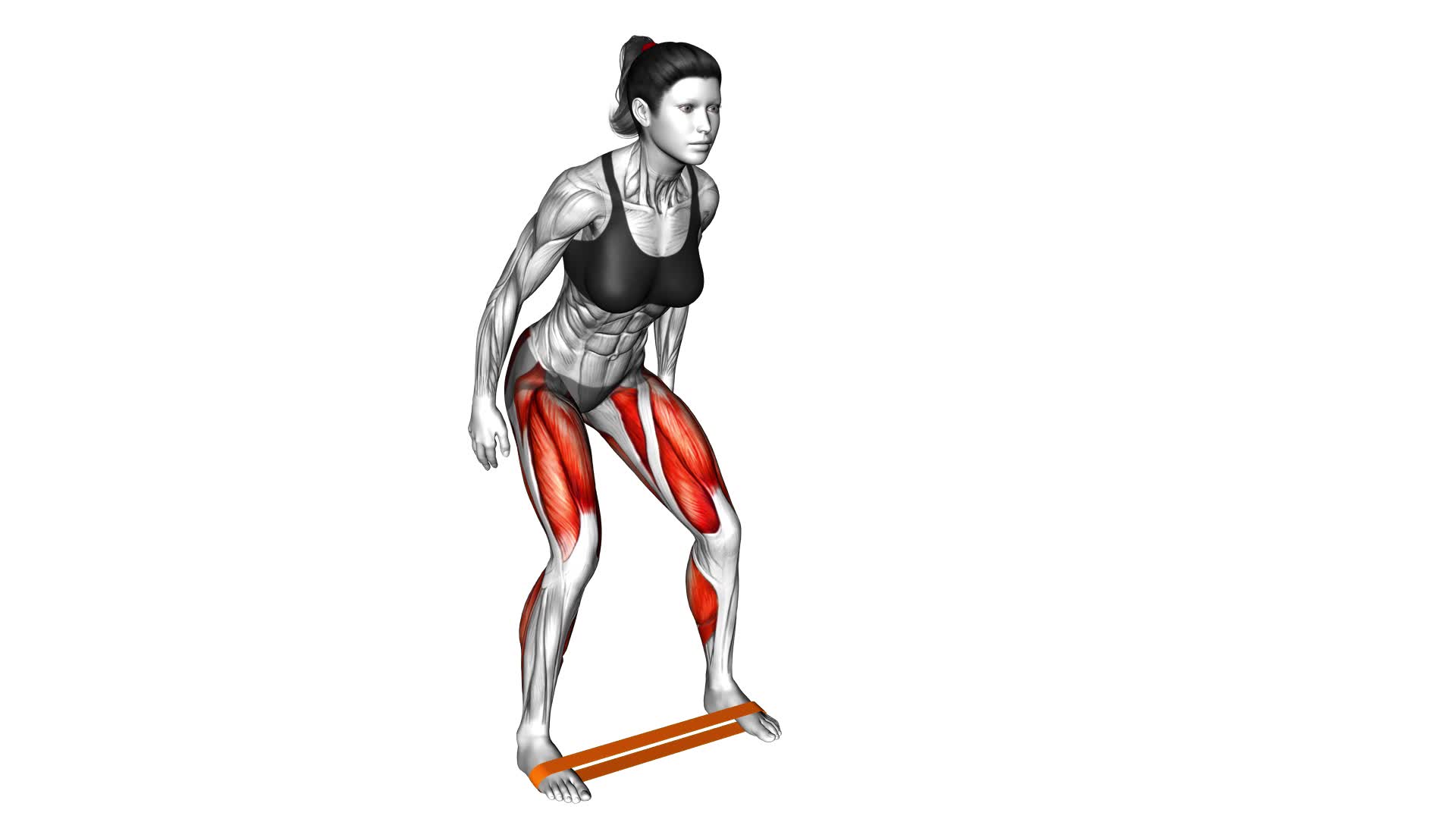Resistance Band Lateral Walk (female) – Video Exercise Guide & Tips

Are you looking for a simple yet effective exercise to strengthen your lower body? Look no further than the resistance band lateral walk.
Watch This Exercise Video
This video exercise guide will show you how to properly perform this movement, targeting your glutes and hips.
With variations to challenge yourself and tips to avoid common mistakes, you'll be able to get the most out of your workout.
So grab your resistance band and get ready to take your fitness to the next level!
Key Takeaways
- Resistance Band Lateral Walk targets muscles in hips, glutes, and thighs.
- It helps build strength and stability, improving athletic performance.
- This exercise can help prevent injuries by engaging hip abductor muscles.
- Proper form and technique, as well as varying the resistance, are key for maximizing the workout.
Benefits of Resistance Band Lateral Walk
Get stronger and improve your lateral stability with the benefits of the Resistance Band Lateral Walk exercise. This exercise is highly effective in targeting the muscles in your hips, glutes, and thighs. By incorporating Resistance Band Lateral Walk into your workout routine, you can build strength and stability in these areas, leading to improved athletic performance and injury prevention.
One of the key benefits of Resistance Band Lateral Walk is its ability to engage the hip abductor muscles. These muscles are responsible for moving your legs away from the midline of your body, and by targeting them with this exercise, you can strengthen and tone them effectively. This can be particularly beneficial for athletes involved in sports that require lateral movements, such as basketball or soccer.
Additionally, the Resistance Band Lateral Walk can be modified to suit different fitness levels and goals. For beginners, starting with a lighter resistance band or performing the exercise without a band can be a great way to gradually build strength. On the other hand, more advanced individuals can increase the resistance or incorporate additional variations, such as side steps with a squat or lateral lunges.
Incorporating Resistance Band Lateral Walk into your workout routine can yield significant benefits in terms of strength, stability, and injury prevention. Whether you're a beginner or an advanced athlete, modifying the exercise to suit your needs and goals will ensure that you continue to challenge yourself and see progress over time.
Setting Up for the Exercise
To set up for the Resistance Band Lateral Walk, start by placing your feet shoulder-width apart and ensuring that your toes are pointing forward.
Secure the resistance band around your ankles, making sure it's snug and won't slip off during the exercise.
Lastly, choose a band with the right tension for your fitness level, as you want to feel resistance but still be able to maintain proper form and control throughout the movement.
Proper Foot Positioning
Are you wondering how to position your feet correctly for the Resistance Band Lateral Walk exercise? Proper foot positioning is crucial to ensure maximum effectiveness and prevent injuries.
To achieve correct foot alignment, start by placing your feet hip-width apart. Make sure your toes are pointing forward and slightly outward. Avoid common foot positioning mistakes such as turning your toes inward or outward excessively. This can put unnecessary stress on your knees and ankles.
Keep your weight evenly distributed between both feet throughout the exercise. By maintaining proper foot position, you'll engage the correct muscles and maintain stability, allowing you to get the most out of your Resistance Band Lateral Walk.
Securing the Resistance Band
To properly set up for the Resistance Band Lateral Walk exercise, follow these steps:
- Secure the resistance band around your ankles. Make sure the band is snug but not too tight, allowing for freedom of movement.
- To attach the resistance band, loop it around one ankle, then cross it over to the other ankle, ensuring it's secure.
- If you don't have a resistance band, there are alternative options you can use, such as resistance loops or even a long resistance band tied in a loop. These options provide similar resistance and can be used in the same way.
- Once the resistance band is securely attached, you can move on to finding the right tension for the exercise.
Finding the Right Tension
Ensure your resistance band is at the right tension for the exercise by adjusting it to your desired level. To achieve the appropriate tension, follow these steps:
- Start with a light resistance band and gradually increase the tension as needed.
- Adjust the length of the band by either holding it closer or further away from the anchor point.
- Experiment with different bands to find the one that offers the ideal resistance for your fitness level.
- Keep in mind that the band should provide enough resistance to challenge your muscles, but not too much that it compromises your form.
- Listen to your body and make adjustments accordingly.
By choosing the right band and adjusting the tension properly, you can ensure an effective workout.
Now, let's move on to the next section and learn about proper form and technique for the resistance band lateral walk exercise.
Proper Form and Technique
Maintain proper form and technique while performing the Resistance Band Lateral Walk to maximize its effectiveness. By ensuring you have the correct form, you can avoid common errors and achieve the best possible results from this exercise.
First and foremost, it's important to maintain a slight bend in your knees throughout the entire movement. This helps to engage the muscles in your lower body and keeps your joints protected. Keep your back straight and engage your core to maintain stability.
When taking steps to the side, make sure to keep tension on the resistance band at all times. This ensures that your muscles are continuously engaged and working against the resistance. It's also important to take small, controlled steps rather than rushing through the movement. This allows you to focus on the muscles being targeted and maintain proper balance.
Additionally, pay attention to your foot placement. Try to keep your feet parallel and avoid turning them inwards or outwards. This helps to engage the correct muscles and prevents any unnecessary strain on your joints.
By following these proper form and technique guidelines, you can maximize the results of the Resistance Band Lateral Walk and effectively target your glutes, hips, and thighs.
Now, let's explore some variations to challenge yourself and take your workout to the next level.
Variations to Challenge Yourself
Take your Resistance Band Lateral Walk to the next level by incorporating challenging variations. These progression options won't only add excitement to your workout routine but also increase muscle activation for better results.
Here are five variations to challenge yourself:
- Resistance Band Lateral Walk with Mini Band: Place a mini band around your knees or ankles to add extra resistance and intensify the workout.
- Resistance Band Lateral Walk with Squat: Perform a squat before each step to engage your glutes and quadriceps even more.
- Resistance Band Lateral Walk with Overhead Press: Hold dumbbells at shoulder level and perform an overhead press while stepping sideways. This variation adds upper body strength and stability training.
- Resistance Band Lateral Walk with Resistance Band Pull-Apart: Hold a resistance band with both hands in front of you and pull it apart as you step sideways. This variation targets your upper back and shoulders.
- Resistance Band Lateral Walk with High Knee: Lift your knees higher as you step sideways to add a cardio element and further engage your core and hip flexors.
Incorporate these challenging variations into your Resistance Band Lateral Walk routine to take your workouts to new heights. Remember to maintain proper form and technique throughout each exercise to maximize your results and prevent injury.
Keep pushing yourself and enjoy the benefits of increased strength and muscle activation.
Common Mistakes to Avoid
To avoid hindering your progress and achieving optimal results, it's important to be aware of common mistakes that can occur during the Resistance Band Lateral Walk exercise. By understanding these mistakes and focusing on proper technique, you can maximize the effectiveness of this exercise.
One common mistake to avoid is allowing your knees to cave inwards as you step sideways. This can put unnecessary strain on your knees and compromise your form. To prevent this, make sure to keep your knees aligned with your toes throughout the movement. Engage your glutes and abductors to maintain proper alignment and stability.
Another mistake isn't maintaining tension in the resistance band. The band should be stretched and provide resistance throughout the entire exercise. Avoid allowing slack in the band by keeping your feet shoulder-width apart and applying constant tension. This will ensure that you're engaging the targeted muscles and getting the most out of the exercise.
Lastly, avoid using momentum to move quickly through the exercise. It's important to perform the lateral walk with control and precision. Take slow and deliberate steps, focusing on engaging your glutes and abductors with every movement. This will help you build strength and stability in your lower body.
Tips for Getting the Most Out of Your Workout
Maximize your workout by incorporating these tips to get the most out of your Resistance Band Lateral Walk:
- Vary the resistance: To maximize results and avoid workout plateaus, try using different resistance bands or adjusting the tension of your current band. This will challenge your muscles in new ways and prevent adaptation.
- Focus on form: Proper form is crucial for targeting the right muscles and avoiding injuries. Keep your back straight, engage your core, and maintain a slight bend in your knees throughout the exercise. Also, make sure to step sideways with controlled movements and avoid excessive swinging.
- Add intensity with speed: Increase the intensity of your workout by performing the Resistance Band Lateral Walk at a faster pace. This will elevate your heart rate, burn more calories, and provide a cardiovascular challenge on top of the strength training benefits.
- Incorporate variations: Don't be afraid to mix things up and add variations to your Resistance Band Lateral Walk. You can try adding a squat at each step, incorporating lateral lunges, or even performing the exercise on an unstable surface like a balance board.
- Stay consistent: Consistency is key when it comes to maximizing your results. Aim to incorporate the Resistance Band Lateral Walk into your workout routine at least two to three times a week. This will help you build strength, improve endurance, and avoid hitting a workout plateau.
Frequently Asked Questions
How Many Repetitions Should I Aim for When Performing the Resistance Band Lateral Walk?
When performing the resistance band lateral walk, aim for a specific number of repetitions to maximize the benefits. The repetition recommendations may vary depending on your fitness level and goals. However, a general guideline is to start with 8-12 repetitions per set.
As you progress and become more comfortable with the exercise, you can gradually increase the number of repetitions. Remember to listen to your body and adjust the intensity accordingly.
Can I Do the Resistance Band Lateral Walk Exercise if I Have Knee or Hip Problems?
If you have knee or hip problems, it's important to be cautious when considering the resistance band lateral walk exercise. Consult with a healthcare professional to determine if it's safe for you.
This exercise involves lateral movements that can put strain on your knees and hips. If you're given the green light, start with a light resistance band and focus on maintaining proper form and technique.
Listen to your body and stop if you experience any pain or discomfort.
Is It Necessary to Use a Resistance Band for This Exercise, or Can I Use Other Equipment?
To answer your question about using alternative equipment for the resistance band lateral walk exercise, it isn't necessary to use a resistance band, but it's highly recommended.
The resistance band provides added resistance, targeting the muscles in your hips and thighs more effectively.
If you don't have a band, you can try using ankle weights or a looped resistance band around your thighs.
However, the benefits of using a resistance band, such as increased strength and stability, may not be fully achieved with alternative equipment.
Can the Resistance Band Lateral Walk Help With Toning the Glutes and Thighs?
Yes, the resistance band lateral walk can definitely help tone your glutes and thighs. Resistance band exercises are great for overall lower body toning. They provide added resistance to your muscles, making them work harder and resulting in increased muscle activation and toning.
The lateral walk specifically targets the glutes and outer thighs, helping to strengthen and tone those areas. Incorporating resistance band exercises into your workout routine can have great benefits for glute activation and overall lower body toning.
How Often Should I Incorporate the Resistance Band Lateral Walk Into My Workout Routine for Best Results?
For optimal results, incorporate the resistance band lateral walk into your workout routine at least 2-3 times a week.
This exercise targets your glutes and thighs, helping to tone and strengthen those areas.
By regularly including the resistance band lateral walk, you can improve your overall lower body strength and stability.
It's important to remember to start with a lighter resistance band and gradually increase the intensity as you become more comfortable with the exercise.
Conclusion
In conclusion, the resistance band lateral walk is a highly effective exercise for targeting the muscles in your hips, glutes, and thighs. By incorporating this exercise into your routine, you can improve your overall strength, stability, and balance.
Remember to maintain proper form and technique, and feel free to challenge yourself with variations as you progress. Avoid common mistakes and follow the tips provided to get the most out of your workout.
Start incorporating the resistance band lateral walk into your fitness routine today for maximum results.

Author
Years ago, the spark of my life’s passion ignited in my mind the moment I stepped into the local gym for the first time. The inaugural bead of perspiration, the initial endeavor, the very first surge of endorphins, and a sense of pride that washed over me post-workout marked the beginning of my deep-seated interest in strength sports, fitness, and sports nutrition. This very curiosity blossomed rapidly into a profound fascination, propelling me to earn a Master’s degree in Physical Education from the Academy of Physical Education in Krakow, followed by a Sports Manager diploma from the Jagiellonian University. My journey of growth led me to gain more specialized qualifications, such as being a certified personal trainer with a focus on sports dietetics, a lifeguard, and an instructor for wellness and corrective gymnastics. Theoretical knowledge paired seamlessly with practical experience, reinforcing my belief that the transformation of individuals under my guidance was also a reflection of my personal growth. This belief holds true even today. Each day, I strive to push the boundaries and explore new realms. These realms gently elevate me to greater heights. The unique combination of passion for my field and the continuous quest for growth fuels my drive to break new ground.







